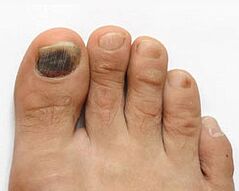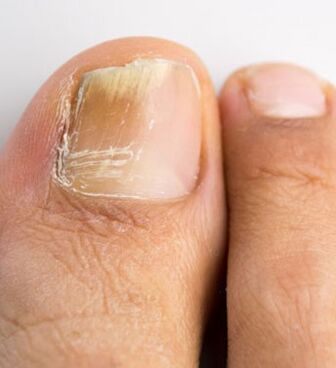
Fungal disease is very often diagnosed in dermatology. Walking barefoot on the beach, lack of changeable shoes when visiting saunas and baths, wearing other people's shoes, boots, etc. Wearing helps to spread the disease on the toes. According to statistics, the most common damage to nail plates. starts with the thumb. This is due to the specificity of the anatomical structure of the nail and a significant subungual space. If you seek timely medical attention, the disease will not cause much discomfort and will be nothing more than a temporary cosmetic defect.
Symptoms of the disease
A fungal infection that enters under the nail plate quickly finds a nutrient medium for itself and begins to multiply actively. During this period, a person may experience no symptoms or a slight itching and redness in the nail area. In addition, the growth of colonies of pathogens causes more pronounced symptoms, which lead to seeking advice from a medical facility. If you treat nail fungus on the thumb at an early stage, you can prevent many unpleasant complications. The main symptoms include:
- nail discoloration;
- appearance of spots underneath;
- lack of natural radiance;
- increased fragility;
- nail deformation.
The longer the disease is not treated, the more negative the effect of the fungus: the body of the nail thickens, the shape changes a lot. Such a toe causes pain when trying to wear tight shoes or in case of accidental mechanical injury. In the future, the nail completely loses its healthy appearance, collapses, wears out and can come out of the nail bed.
Causes of fungus on the big toe
The causative agents of the disease are three groups of pathogenic fungi: yeast-like, mold and dermatomycetes. Their prevalence in the environment is very high, so there can be many ways of infection. However, not all people are exposed to dangerous contact, because immunity works to protect health. Treatment of fungal infections of the thumb is often required for people with reduced resistance to such infections. In addition, the disease can be caused by:

- frequent damage to the thumb;
- non-compliance with hygiene standards;
- presence of fungal skin lesions;
- diabetes;
- overweight;
- vascular diseases;
- varicose veins of the lower extremities.
Weak immunity has a special place among the predisposing factors. Past viral infections, often colds, sore throats, and poisonings deprive the body of protection against fungal infections and increase the risk of infection. In addition, the lack of nutrients and the frequent occurrence of cracks and other injuries in the area of the thumb reduce local immunity and can lead to a disease.
Which doctor should I see?
If you are worried about any unpleasant symptoms related to toenails, you should consult a doctor as soon as possible. Itching, redness, discoloration may indicate an impending disease. Professional help in this matter will be provided by a doctor.
It specializes in various skin diseases and will help to skillfully treat nail fungus on the big toe. First, a comprehensive diagnosis is made, including anamnesis, examination, and some laboratory tests. A dermatologist may prescribe several supplements to more fully assess the patient's condition questions:
questions:
- Since when do you feel the changes in your nails?
- What was your first concern?
- Has the nail plate changed color?
- How long did it take to change the uniform?
- What do you do?
- Do you often visit saunas and baths?
- Have you ever had a fungal infection on your body?
After additional examinations, the patient should consult a dermatologist again. Based on the results obtained and the clinical picture, the doctor prescribes therapy for the disease.
Treatment
The effectiveness and duration of therapy for the disease directly depends on the early seeking of medical care and the correct scheme. Ointments and gels for external use with an antifungal component are an effective tool in the early stages of the disease. In this case, it is important to correctly identify the pathogen and fight it. Other treatments are also available:
- complex therapy;
- physiotherapeutic effect;
- laser therapy;
- removal of nails;
- elimination of concomitant diseases.
In more complex cases of pathology, an integrated approach, including antifungal drugs for general and internal use, including general tonics, is indicated. In addition to medication, it is a low-sugar diet. The parasite creates favorable conditions for the growth of fungi. We recommend for a faster recovery process:
- to take vitamin complexes;
- lead an active lifestyle;
- perform daily disinfection procedures;
- to strictly adhere to the treatment regimen;
- to give up bad habits.
An important place in the final stage of therapeutic measures is the prevention of relapses and strengthening immunity. Patients are not advised to walk barefoot on the beach, try on others' shoes, or allow their feet to sweat frequently.
Possible complications
The aesthetic flaw is far from anything a mushroom can do. In advanced conditions, the nail grows excessively, becomes extremely painful, grows on the adjacent skin, and a secondary infection and a purulent lesion may combine. In this case, the treatment of nail fungus will be a long and laborious process. In addition to local adverse effects, pathogens have a devastating effect on the whole organism, the following are possible:
- allergies;
- dermatitis;
- blood poisoning;
- intoxication;
- somatic diseases.
As strains of fungi multiply, their waste products turn into poison, poisoning a person and depriving his immune system of protection. In this case, the probability of various viral or bacterial lesions is very high. There is a significant deterioration in overall health and performance.















